Contents:
Common Names | Parts Usually Used | Plant(s) & Culture | Where Found | Medicinal Properties | Biochemical Information
Legends, Myths and Stories | Uses | Warning | Bibliography
Scientific Names

- Paeonia officinalis L.
- Rununculaceae
- Peony family
Common Name
- Common peony
Parts Usually Used
Root
Back to Top

Description of Plant(s) and Culture
The peony is a perennial plant; the thick, knobby rootstock produces a green, juicy stem from 2-3 feet high. The leaves are ternate or bi-ternate, with large, ovate-lanceolate leaflets. The large, solitary, red or purplish-red flowers resemble roses and bloom from May to August.
Other varieties: The tree peony (P. suffruticosa); the root is used similarly to the common peony. The wild peony (P. brownii); a tea from roots for lung trouble. Batipi, (N. Paiute); Doo yah gum hoo (Washoes); Newatama, (Paiute).
Back to Top
Where Found
Grows wild in southern Europe and is cultivated as a garden flower elsewhere.
Back to Top
Medicinal Properties
Antispasmodic, astringent, diuretic, emmenagogue, sedative
Cultivated peony used as blood tonic
Wild red peony used more as an emmenagogue
Back to Top
Biochemical Information
5% asparagin and benzoic acid, also paeoniflorin, paeonol, paeonin, triterpenoids, sistosterol
Back to Top
Legends, Myths and Stories
Nez Perce Indians said to be the finest light cavalry in the world at the time of Chief Joseph, were very horse-conscious, and lost no opportunity to improve horse-racing. The seeds of wild peony were chewed and then put in the horse’s mouth an instant before the race began. He always won.
According to the Roman writer Pliny the Elder (23-79 AD), the peony was the oldest of all cultivated flowers, during the Trojan Wars. Modern botanists have no way of authenticating Pliny’s statement, but we do know that the Chinese emperor Chin Ming (2737-2697 BC) cultivated these flowers. The peony takes its name from the Greek legendary physician Paeon who first learned of the plant’s important medicinal use of lessening the pains of childbirth. Paeon was said to have been eventually transformed into a peony by Zeus. In the Middle Ages ground peony seeds were taken as a preventative against bad and melancholy dreams.
Today, the root is still valued in Chinese medicine, where 2 species are used: both the red-and-white flowered (P. lactiflora) and (P. suffruticosa) or the tree peony.
Back to Top
Uses
In Europe, the Peony root is an old remedy for jaundice and for kidney and bladder problems. An extract made by steeping the root in wine was generally used. A decoction of the root has been used for gout, asthma with cramps, dysmenorrhea, and in very small doses, eclampsia. Cultivated peony used as blood tonic; wild red peony used more as an emmenagogue. Also used for chorea, epilepsy, spasms and other neurological affections. In large doses it is said to be emetic and cathartic.
Externally, bruised root applied to wounds soon heal and quickly takes away the black and blue marks of bruises and blows.
Back to Top
Warning
The entire plant is poisonous, the flowers especially so. A tea made from flowers can be fatal. Do not use without medical supervision.
Back to Top
Bibliography
![]() American Folk Medicine
American Folk Medicine, by Clarence Meyer, Meyerbooks, publisher, PO Box 427, Glenwood, Illinois 60425, 1973
![]() The Complete Medicinal Herbal
The Complete Medicinal Herbal, by Penelope Ody, Dorling Kindersley, Inc, 232 Madison Avenue, New York, NY 10016, First American Edition, copyright 1993
![]() Chinese Medicinal Herbs
Chinese Medicinal Herbs, compiled by Shih-Chen Li, Georgetown Press, San Francisco, California, 1973.
![]() The Complete Medicinal Herbal
The Complete Medicinal Herbal, by Penelope Ody, Dorling Kindersley, Inc, 232 Madison Avenue, New York, NY 10016, First American Edition, copyright 1993
![]() The Herbalist Almanac
The Herbalist Almanac, by Clarence Meyer, Meyerbooks, publisher, PO Box 427, Glenwood, Illinois 60425, copyright 1988, fifth printing, 1994
![]() The Herb Book
The Herb Book, by John Lust, Bantam Books, 666 Fifth Avenue, New York, NY. copyright 1974.
![]() Indian Uses of Native Plants
Indian Uses of Native Plants, by Edith Van Allen Murphey, Meyerbooks, publisher, PO Box 427, Glenwood, Illinois 60425, copyright 1958, print 1990
![]() Planetary Herbology
Planetary Herbology, by Michael Tierra, C.A., N.D., O.M.D., Lotus Press, PO Box 325, Twin Lakes. WI 53181., Copyright 1988, published 1992
 Secrets of the Chinese Herbalists
Secrets of the Chinese Herbalists, by Richard Lucas, Parker Publishing Company, Inc., West Nyack, NY, 1987.
![]() The Yoga of Herbs: An Ayurvedic Guide to Herbal Medicine
The Yoga of Herbs: An Ayurvedic Guide to Herbal Medicine, by Dr. David Frawley & Dr. Vasant Lad, Lotus Press, Twin Lakes, Wisconsin, Second edition, 1988.
![]() Webster’s New World Dictionary
Webster’s New World Dictionary, Third College Edition, Victoria Neufeldt, Editor in Chief, New World Dictionaries: A Division of Simon & Schuster, Inc., 15 Columbus Circle, New York, NY 10023
